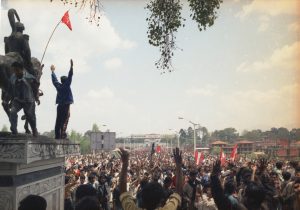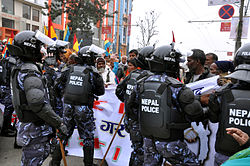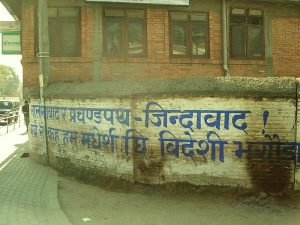Minds of the Movement
An ICNC blog on the people and power of civil resistance
by Ches Thurber and Subindra BogatiApril 23, 2021
An ICNC webinar took place on April 27, 2021 featuring the authors of this blog post:
From the Hills to the Streets to the Table: Civil Resistance and Peacebuilding in Nepal
Between 1996 and 2006, Nepal experienced a civil war that resulted in the deaths of over 17,000 people. The beginning of the conflict caught by surprise political leaders and international observers alike. The country had just transitioned to a parliamentary system—brought about by the largely nonviolent Jana Andolan or “People’s Movement” of 1990—and many believed Nepal was on a stable and peaceful path toward democracy.
Just as remarkable, however, was how the conflict ended: with the Maoist guerrillas putting down their weapons and joining other political parties in a successful civil resistance campaign. The 19 days of sustained nonviolent mobilization and mass civil resistance actions achieved what 10 years of violent struggle could not: An end to the king's political powers and a path forward for the Comprehensive Peace Agreement (CPA), which ended the civil war.
How was this campaign possible? How were the Maoist rebels convinced to transition from an armed to an unarmed strategy of resistance? And how has the subsequent peace process fared in terms of both preventing a return to physical violence as well as addressing deeper structural inequalities? In a new ICNC Special Report, we tackle these questions, analyzing the interplay of civil resistance and peacebuilding strategies across four phases of Nepal’s conflict.

Masses of people in Kathmandu during the 1990 Nepalese revolution. Source: Wikipedia/Min Ratna Bajracharya (CC BY-SA 4.0, unedited).
The interplay between civil resistance and peacebuilding in Nepal
We leverage a theoretical framework introduced by Veronique Dudouet in her 2017 ICNC Special Report, Powering to Peace: Integrating Civil Resistance and Peacebuilding Strategies. Civil resistance and peacebuilding are approaches to conflict transformation that share a commitment to the pursuit of social justice through nonviolent means. However, they differ in their normative assumptions, their diagnoses of the causes of conflict, and their suggested methods for achieving social change. While peacebuilding frequently promotes dialogue through official channels, civil resistance prescribes the use of grassroots mobilization and pressure to level power differences between groups.
Nepal represents such a case of power asymmetry. It is an example of a highly unequal society where power differences between ethnic, caste, class, and religious groups create political grievances as well as an uneven playing field for social dialogue. As such, it is exactly the kind of case where we might expect peacebuilding efforts to fall short. Deeply-rooted structural hierarchies of power give privileged actors little incentive to compromise. It is in this context that Dudouet suggests civil resistance could play an important role as a pre-negotiation strategy, allowing oppressed groups to use nonviolent tactics to pressure incumbents to redistribute power.
Our research concerning the conflict in Nepal led us to arrive at the following five general conclusions:

Confrontation between police and protesters during the 2006 Nepalese revolution. Source: Wikipedia/Soman.
As social injustices receive greater attention, an absence of civil resistance and peacebuilding strategies can result in grievances being channelled toward violent alternatives.
The period of democratization in the early 1990s in Nepal produced new discourses, new civil society organizations, and new social mobilizations around issues of structural inequalities and identity-based oppression. However, as awareness of injustice grew among marginalized groups, a lack of peacebuilding and civil resistance strategies led rural Nepalis to gravitate toward the Maoists and their program of protracted “People’s War.”
Marginalized groups may be among the least likely to see civil resistance and peacebuilding strategies as viable solutions to their problems.
There was no lack of awareness of civil resistance as a strategy in Nepal in the early 1990s; a major civil resistance movement had brought democracy to the country in 1990. Nevertheless, civil resistance was widely perceived, especially among oppressed groups, as a strategy of the elite, used by middle-class urbanites in pursuit of political power and as largely irrelevant to the plight of rural, marginalized communities seeking broader social and economic change.

Maoist wallpainting in Kathmandu, just opposite the US Embassy (2006). Source: Wikipedia/Soman.
The combination of peacebuilding and civil resistance strategies can be effective at toppling entrenched power structures.
In the end, not even three weeks of sustained mass civil resistance actions accomplished what a decade of civil war could not—forcing the king to relinquish power. Dialogue and negotiation produced the opposition coalition between the Maoists and political parties that made effective civil resistance possible.
Civil resistance can channel frustrations long after conflict.
Actors dissatisfied with political developments after the CPA have repeatedly turned to civil resistance tactics to express discontent and seek leverage over those in official positions of power. While there has been fear of escalation to violence, and several violent episodes, there has been no return to large-scale civil war, as has frequently occurred in other post-conflict environments.
However, civil resistance may only partially balance power inequalities, undermining conflict settlements.
The success of civil resistance in Nepal was the result of partnership between marginalized and privileged groups. Because of this, elites were still in a position to dominate post-conflict politics. Perhaps if marginalized groups had continued mobilization through the conflict settlement phase, they might have been able to secure additional protections in the CPA. One reason conflict settlement came so quickly is that it was ambiguous about many of the divisive social issues that had been the original drivers of the conflict. But this is a double-edged sword; attempts at resolving all of these contentious issues in the conflict settlement phase may have risked a return to overt conflict.
Prospects for an enduring peace
Fifteen years after the signing of the CPA, Nepal is a relatively peaceful, democratic country. It has avoided a return to major armed conflict, held three competitive nation-wide elections, transitioned through multiple changes of political leadership with relatively minimal violence, and finally passed a new constitution in 2015.
However, the post-conflict period has also featured significant political gridlock. Political demonstrations have in many cases escalated to violence, and some factions have even turned to terrorist bombings. And many historically marginalized communities see the political system as having failed to meet their expectations for change following the civil war, while privileged groups see the social fabric of the nation as imperiled by a reversion to sub-national identities.
Examining the interplay between civil resistance and peacebuilding strategies over the trajectory of this conflict can help us better understand how they played an instrumental role in helping end a civil war, but also fell short of fully addressing deeper social conflicts. We hope this analysis offers valuable lessons both for the future progress in Nepal as well as for successful conflict transformation in other contexts.

Ches Thurber
Ches Thurber is an Assistant Professor in the Department of Political Science at Northern Illinois University. His book, Between Mao and Gandhi: The Social Roots of Civil Resistance, will be published by Cambridge University Press in 2021. He received his PhD from The Fletcher School of Law and Diplomacy at Tufts University.
Read More
Subindra Bogati
Subindra Bogati is the Founder and Chief Executive of the Nepal Peacebuilding Initiative, with more than 15 years’ experience working with various national and international organizations on peacebuilding, governance and development issues. Lately, his research, teaching, and policy-oriented work focus on peacebuilding and political violence.
Read More